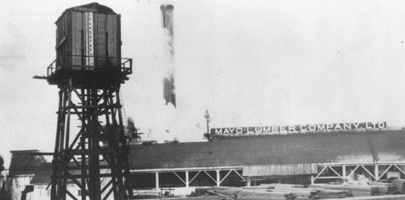





|

|
Darshan Sangha recalls, " We all really cared and looked after one another. Off course we played jokes on each other, but only
in good humor, never to hurt the other person’s feelings. We would all share any newspaper that we would get. Sometimes we
would even get a newspaper from India. One of the good things about our people at that time was that if someone had just
come from India, we would help that person find a job. We would go from one mill to the next asking, and until the job was
found, we would pitch in and pay their room and board. If someone were visiting from another area even then, we would not
let them pay. If a fellow villager from India came, they would ask if he owed anyone money back home, or if anyone there
needed any money. If there was a need of money they would give him their cheques and tell him to send the money to India and
he could pay them back slowly. "
The largest mill community was located at Fraser Mills in New Westminster, close to Maillardville. The Sikhs called it
" Millside. " According to Mawa Mangat, who came to Canada in 1925, " There were only two families here then, the rest were
all single men. " The company even built a temple for its workers in about 1908. Sardara Gill, who came to join his father to live
and work here in 1925, says that when he arrived, " there were between 200 to 300 Sikhs. They had four or five cookhouses
and different sized bunkhouses, some had thirty, forty or fifty people living in them. That’s how they lived then. We had our
own temple, a small one built by the mill at their own expense. It was a very good company, but for wages there was a
five-cent difference between us and white people. We got twenty-five cents an hour and the whites got thirty cents for the same
job. "
" My dad was pulling lumber on the greenchain, it was hard work. We’d start at 8 o’clock and finish at 5 o’clock. Sometimes I
did five hours overtime, thirteen hours a day. Most Saturdays and Sundays I worked as well, so seven days a week. We did
not get paid overtime in those days. We got a little extra for working on Sundays, we’d work eight hours and they would pay
us for ten hours. "
Small groups of Sikhs lived around several other small lumber mills and lumber yards in different parts of the Lower Mainland.
Clusters of four or five households were built on Main Street, Marine Drive and Fraser Street in Vancouver, on Mitchell Island
in Richmond, and Dollarton in North Vancouver. Some Sikhs also lived in the Cedar Cottage area because of its central
location for the wood truck business and the availability of lots for wood storage.
From the beginning, the Sikhs were respected as being very hard workers, reliable and trustworthy. This is why the mills would
hire them. As time went on, Sikhs sought better wages and better working and living conditions. Because of their strong
communication network, they knew what type of work and what wages were available throughout the province. They were
enterprising and extremely mobile. They would travel great distances for better working conditions or to make better pay.
Other avenues of employment related to mill work started to open up in the mid-1930s. Besides the independent wood truck
business based in Vancouver and Victoria, Sikhs started getting labour contracts in the mills: on the greenchain, loading
boxcars, in the dry kiln, hauling wood or sawdust or cutting poles or ties. Some even had their own lumber mills, usually located
out of Vancouver. This greatly expanded their financial opportunities and gave them more economic freedom and autonomy.
The major Sikh mill owners were Mayo Singh and Kapoor Singh. Mayo Singh came from India in 1906 with little education.

|
|
Mayo Lumber Company Ltd.
|
He first started working in the farms in Chilliwack and later in the lumber mills. Kapoor Singh, an educated man, graduated
from high school in India and went to San Francisco in 1906. He traveled up and down the Pacific Coast and later to Toronto.
His interest in the lumber industry eventually brought him in contact with Mayo Singh. Their first joint business venture began
when they became partners with other Sikhs and bought out a failing lumber mill inn New Westminster in 1914. They had all
been employees there and knew the work. The lumber market was poor due to the war, but with some luck and plenty of hard
work the business became profitable. A few years later, Mayo and Kapoor expanded their business by moving their base of
operations to Vancouver Island.
|
cont...
[p.4]









|







